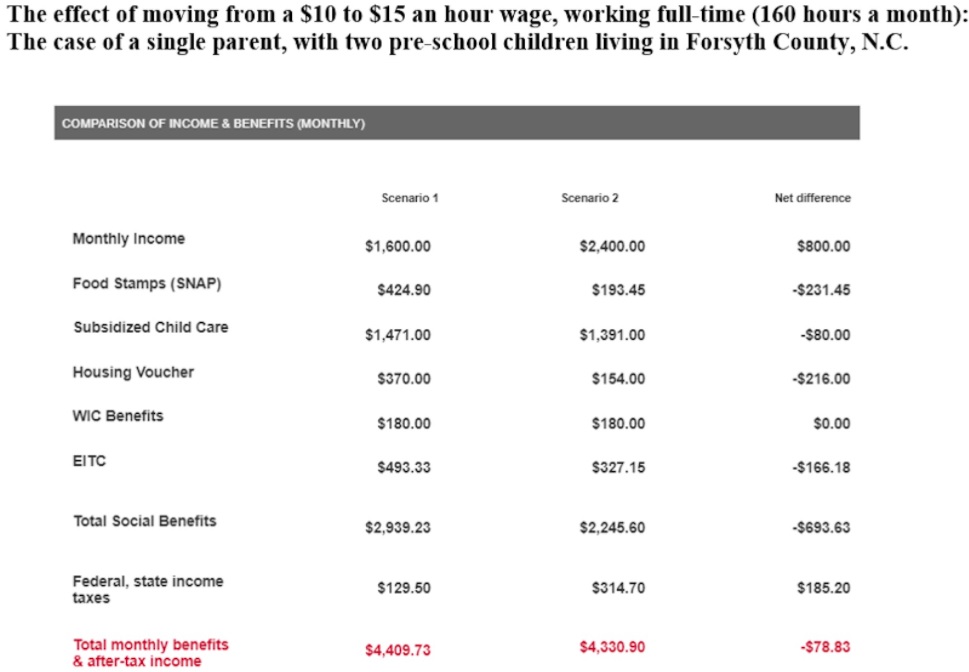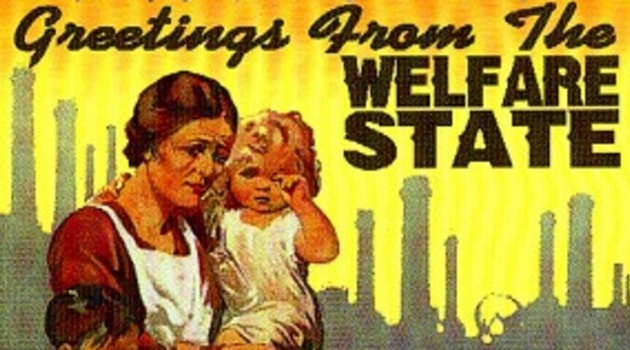The welfare state and the so-called war on poverty has been very bad news for taxpayers.
But it’s also very bad news for poor people, in part because various redistribution programs can lure them out of the productive economy and into total dependency on government (and this will become an even bigger problem if Biden’s per-child handouts are approved).
But it’s also bad news because redistribution programs can result in very high implicit tax rates for low-income people who try to improve their lives by climbing the economic ladder.
I shared an example back in 2012, which showed how a single mother in Pennsylvania would be worse off with $57,000 of income instead of $29,000.
In other words, she would be dealing with a de facto marginal tax rate of more than 100 percent.
If you want to understand how this happens, Professors Craig Richardson and Richard McKenzie wrote about this topic in an article for The Library of Economics and Liberty.
…by expanding public assistance programs, the President’s plan will unavoidably impose a higher, hidden tax rate—known as an “implicit marginal income tax rate” (which we shorten to implicit tax rate)—on low-wage workers who receive welfare benefits. Those workers will pay an implicit tax rate because many welfare benefits are reduced as earnings rise. Ironically, the poorest Americans often pay implicit tax rates that are far higher than the IRS’s explicit marginal income-tax rates imposed on the country’s highest income earners. …Consider a household that receives benefits from only two welfare programs, with one tapering off at 20 cents for each added dollar earned and another tapering off at 40 cents for each added dollar earned. Those cuts create an implicit tax rate of 60 percent, which means the worker has only 40 cents in additional spendable income for each added dollar earned. This implicit tax rate can be expected to affect work incentives in much the same way that a federal income tax rate does.
The authors cite a real-world example.
…consider a real-life, low-income single mother of two children in Forsyth County, North Carolina earning $10 an hour in a full-time job, which means she has a monthly earned income of $1,600 (or $19,200 annually). Suppose the single mother receives monthly benefits from five welfare programs: $425 in food stamps, $1,471 in subsidized childcare, $370 in housing subsidies, $180 in WIC benefits, and $493 in an earned income tax credit (EITC). Her monthly welfare benefits will total $2,939 (or $35,271 a year). Now, suppose the single mother takes a new job paying $15 an hour, a 50 percent increase. Her monthly earned income will rise by $800 to $2,400 (with her annual income rising to $28,800 a year, an annual earnings increase of $9,600). However, she will face decreases in four out of her five monthly benefit streams, with each benefit reduction based on the same $800-increase in earnings (a problem known among welfare researchers as the “cumulative stacked effect”). The single mother will lose $231 in food stamps, $80 in childcare benefits, $216 in housing benefits, and $166 in EITC. Her total decrease in monthly benefits will reach $694 (which means her annual benefit total will drop by $8,328).4 Her implicit tax rate on her added monthly earnings of $800 is 87 percent—more than two times the highest explicit marginal tax rate proposed for the rich. …In addition, the single mother will be required to pay an added $185 a month in federal and state income taxes on her added earned monthly income of $800, which is an explicit tax rate of 23 percent. Adding the 87 percent implicit tax rate to the 23 percent explicit tax rate leads to an overall tax rate of 110 percent. Her raise has left her $79 per month poorer in lost wages and benefits—surely a strong disincentive for her to take the higher paying job.
Here’s a table showing those results.

If you want more evidence, check out Chart 7 from this column and Figure 8 from this column.
And the same problem exists in other nations as well.
P.S. Obamacare may have lured as many as 2 million people into full dependency.
P.P.S. I already mentioned how Biden’s per-child handouts could lure many more into full dependency, but “basic income” could be far worse.



